Mr. Frank;
I have read a lot about when boys swam naked in schools, YMCAs, Boys Clubs, etc. Many men that post their experiences talk about not being modest at all. There are men that say they were naked at swim meets in front of families and friends, as well as a gallery of strangers.
When did it change? When did men become so modest and fearful of being seen naked?
This is a question about modesty and nakedness that uses naked swimming as a reference point. I will discuss the question first in terms of the larger issue of modesty and the body. Then I will assess to the best of my ability male modesty over the last one hundred years. Finally, I will reflect on where things stand today, as I see it. I’m sure others will see it differently.
I would note that there has been a lot of interest (like our questioner’s) in the practice of boys swimming naked in schools and the YMCA some fifty and more years ago among those who didn’t experience it. Sometimes it has been a matter of incredulity. Did that really happen? For many, however, I think it has been a wistful desire to have experienced it. Boys want to be naked, like these boys swimming in a YMCA pool.

The Body Naked and Clothed
Modesty is often applied to how we dress. Don’t be ostentatious in flouting your finery. But it could also be applied to flouting your body by showing lots of flesh. Strike a balance between too much covering and too little. In fact, however, if everyone was naked there would be no discussion about modesty. The issue is raised only because people cover part or all of their naked body.
In our American culture, modesty has to do with how much flesh is exposed in what we wear. This relates to the American obsession with nudity in relation to sex. Of course, fashions change and the perception of what is modest or immodest changes as, for example, women’s hemlines get higher and higher and boys’ belt lines get lower and lower.
Within my reflections on the body I have given attention to the naked body because that is how we feel our bodies most directly if we live in a clothed society. The dialectic of nakedness/enclothed provides an aspect of the body’s meaning, and it is a far more important meaning than we have generally considered.
On the one hand nakedness suggests innocence, truth (“baring all”), and vulnerability. On the other hand the naked body can be the subject of humiliation, shame, and punishment. Adam and Eve were attempting to hide their guilt from God when they grabbed some fig leaves in an attempt to cover their nakedness (by which they meant their genitals). They compounded their sin of eating the forbidden fruit by being ashamed of what God had created good. By covering their “private parts” they also demonstrated an alienation from God, from each other, and from the natural world. (I take the story of Adam and Eve to be an everyman/everywoman story about why things are as they are with us humans. One might call it philosophy in mythic form, which makes it no less real as regards real life.)

Since “the fall” nakedness cannot stand alone; it needs to be considered in juxtaposition with clothing. Clothing provides both modesty and warmth, but dressing the body also provides a way of expressing festivity and personal identity. There is a new field of enclothed cognition that studies the impact of clothing on the wearer’s self-identity. We know we are particular about what brand of clothing wear.
The dialectic nakedness/enclothed is a rich symbolism in many religions. Rites of initiation often include nakedness followed by being clothed in special garments. We have not given enough attention to the experience and meaning of either the naked body or the clothed body. Chapter 3 of my book, Embodied Liturgy: Lessons in Christian Ritual (Fortress Press 2016), Section A deals especially with circumcision and the ancient church’s practice of naked Baptism. Section B deals with being vested in the white baptismal robe (alb) and in priestly vestments. We are properly naked before the Lord, but also dressed before the Lord in liturgical vestments.

The philosopher, Mark Johnson, in The Meaning of the Body (University of Chicago Press 2007), suggests that the meaning of the body is simultaneously biological, ecological, phenomenological, social, and cultural. In terms this schema, both nakedness and clothing are determined by biology, environment, phenomenology, society, and culture. See Frank Answers about the Meanings of the Body for a fuller exposition of Johnson”s schema.
We are, of course, born naked from the womb and are immediately wrapped in blankets. We also experience nakedness when bathing or showering and sometimes sleeping. In other words, we experience nakedness usually only in the privacy of our homes. But it is how we came into the world.
We are more or less naked or more or less clothed in daily life depending on the environmental conditions in which we live. If we live in a cold climate we wear more layers. If we live in a tropical climate we wear only the bare necessities, and this is not considered immodest in those societies unless missionaries tell them otherwise. In temperate zones we experience both hot and cold temperatures and dress accordingly. Venues for public nakedness are few (e.g., some spas, clothing optional beaches), but we wear swimming attire on the beach and at pools and men find opportunities to be shirtless outdoors.
Phenomenologically, we have stored in our bodies’ memories of sensations of being both naked and enclothed. We remember feeling the warmth of the sun and the cooling effects of a breeze on our skin on a hot summer day and also being bundled in warm outer clothing on a cold winter day.
Socially, the degree of allowable public nudity and appropriate clothing are prescribed by the context. Semi-nakedness is allowed on the beach but not in a restaurant off the boardwalk. Places for public nudity is prescribed or proscribed by laws regarding “decency.” How we are dressed or undressed in public is socially conditioned.
Culture determines the style of clothing and body ornaments we wear. In my culture I wear pants and a shirt, and maybe a coat, but not a long robe. In some societies that wear less clothing, festivities are celebrated by directly adorning the body, as in the example of young Ibans of the Sea Dayak people in Borneo (an image used in my above-mentioned book — here it is in color).

Male Modesty in America Over the Last Century
The one activity in which men could get naked in front of other people was swimming. Swimming suits were not invented until the mid-19th century. Before that men swam freely without any clothes in lakes, rivers, and the ocean. Artists like the Englishman Henry Scott Tuke in the early 20th century painted numerous pictures of boys swimming nude at the seashore.

Men and boys past puberty began to be required to cover themselves on urban public beaches to preserve female modesty. Women should not have to look at naked men (although they undoubtedly did earlier). Men also removed their shirts to exercise and to engage in gymnastics as these activities were promoted by the physical culture movement of the 19th century. When physical education became part of the curriculum of schools, boys were also shirtless and wore shorts (as younger boys often did in school anyway). When indoor pools were built beginning in the 1880s, boys and men swam naked as they did outdoors. For purposes of hygiene the American Association of Public Health recommended nude showers and nude swimming for boys in every set of guidelines from 1926 until 1962. Below are photos of a 1953 gym class and a 1941 group shower from LIFE magazine.


The questioner notes that in the posts he read about nude swimming, boys didn’t worry about modesty. This was my experience in the late 1950s in high school swimming classes and at the YMCA. For some freshmen, it was a rite of passage to get undressed in front of one’s peers and the teacher. They may have been filled with trepidation at first, but that wore off quickly. One simply got used to it.
But our society was changing even in the post-war fifties. Families were transitioning from a living situation that provided little privacy to increased privacy in the move from cities to the suburbs. In city flats we may have had one bathroom with a bath tub for the whole family (which was my experience). In the suburban ranch houses there were separate bathrooms for the parents and the children and a powder room with a toilet for guests. Life in the family home became more individualized. It’s not surprising that when the recommendation of nude swimming was not included in the 1962 AAPH guidelines and nylon rather than wool bathing suits were available, mothers began protesting to school boards that their little Johnnies shouldn’t have to expose their “private parts” to other children. School boards tended to preserve the tradition of boys swimming naked in spite of these objections because, they argued, it was “manly” and it prepared the boys for the experience of military service.
In the following picture from the Walla Walla, WA YMCA ca. 1960 the boys and their instructors are nude.
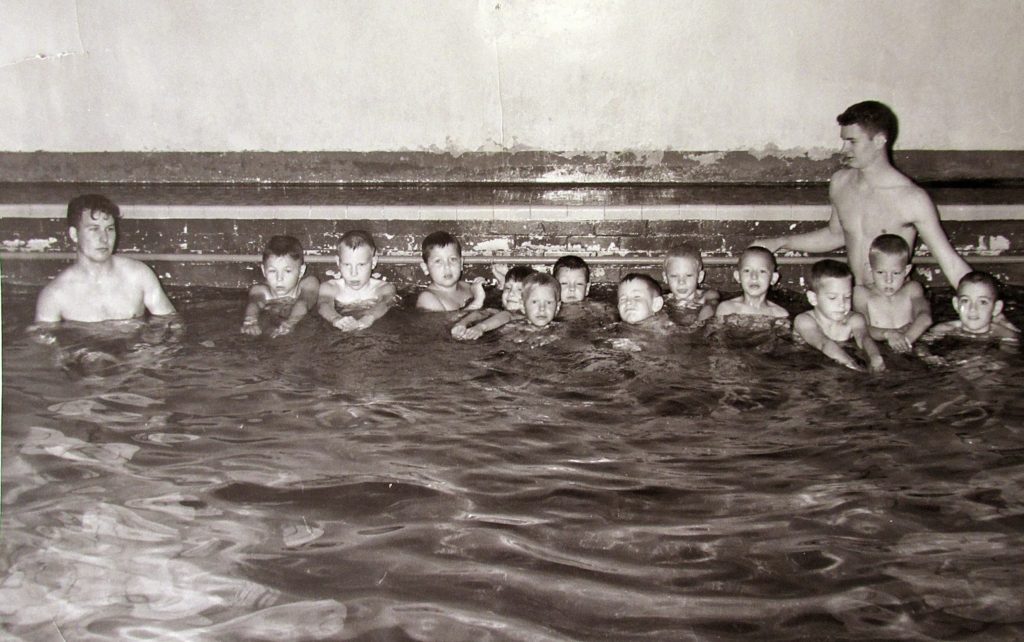
All this changed with the passage of Title IX in 1972, that granted equal access to girls for gym and swimming classes and sports. This didn’t necessarily mandate co-ed classes and sports teams, only that girls should have access to these activities. But the most financially feasible way to accommodate increased use of facilities was to have co-ed gym and swimming classes. The same situation pertained to the YMCA when local associations began to offer membership to girls and women. This spelled the end of boys swimming naked.
At first, boys continued to be shirtless in co-ed gym classes, but eventually this was discouraged. (It would be distracting to the girls, the administrators argued.)

Both boys and girls were issued school gym uniforms of t-shirts and shorts and were required to wear them for all PE classes.

I should note that most of the schools with swimming pools and naked swimming were in the northeast and mid-west. So not all youth experienced naked swimming before 1972 unless they took lessons at a YMCA. Nude showering and swimming was mandatory YMCA policy. There were also swimming meets in schools in which the teams did wear suits by mutual agreement. Any schools that built pools after 1972, such as in the sunbelt states, would undoubtedly provide for co-ed use of the pool and would not permit nude swimming. Some schools, however, continued nude swimming up until around 1980. But the practice was clearly dying out during the 1970s.
The apex of swimming naked was at the Woodstock Music Festiva in 1969 when male and female concert attenders bathed in the lake on the farm. In this age of Hippies, co-ed nude swimming parties took place at some universities and colleges, include Harvard and Antioch in Yellow Springs, Ohio. The film The Harrad Experiment (1973) featured co-ed habitation in dorms, naked classes, and naked swimming in the college pool, which was actually being experimented with in some colleges.
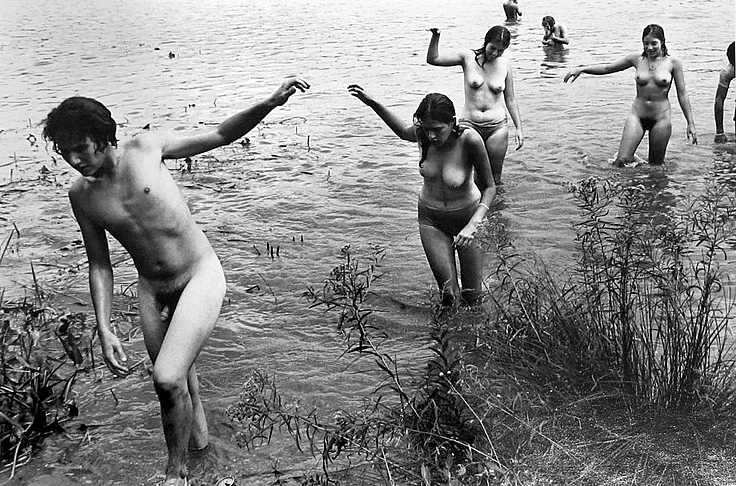
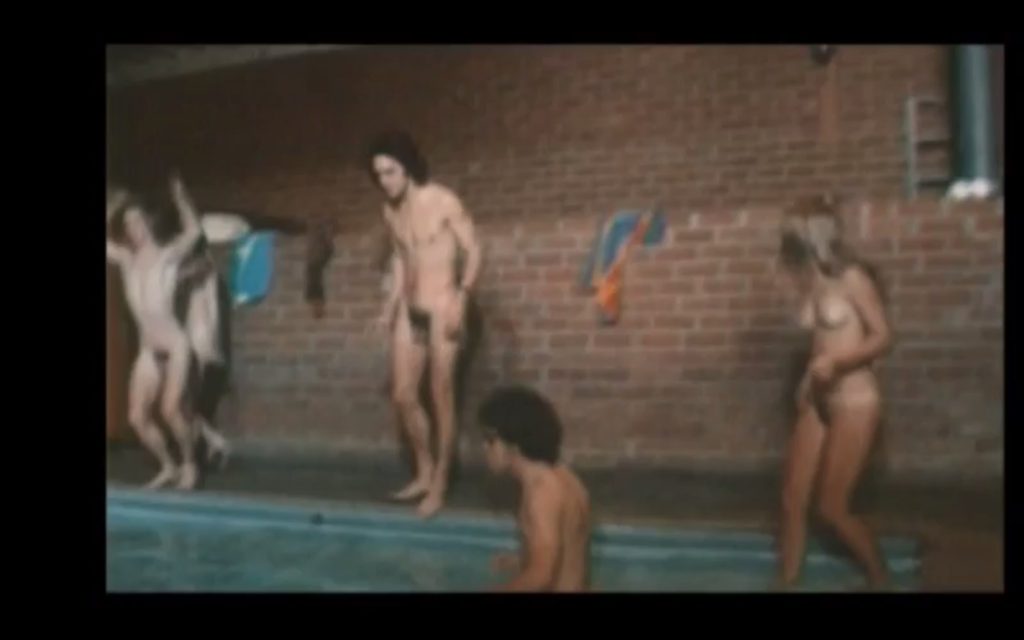
The consequence of the end of boys swimming naked is that after the 1970s boys had no experience of being naked with one another or in front of an audience at a swim meet. Even nude showering began to cease. Physical education teachers and coaches encouraged it because otherwise sweaty boys would be stinky in classes after gym class. But with a short time interval to get from one class to another (like 5 minutes), there wasn’t time for a shower. Moreover, gym class offerings multiplied into a number of activities, some of which would not work up a sweat. Usually only sports teams continued the practice of group showers. In showering before going in the swimming pool students would leave their bathing suits on. I report this on the basis of what my own sons reported on their high school physical education experiences.
Let’s face it, in a clothed society in which there are few opportunities for public nudity, there are few opportunities for boys to experience getting naked with others. If you don’t grow up with this practice, it takes some get used to for older boys. One of the exceptions was the flourishing of suburban back yard swimming pools and hot tubs in the 1980s, in which teen male and male-female nude swimming and bathing was sometimes practiced (with or without parental approval).

Boys Will Still Get Naked
In spite of all the anecdotal evidence of “towel dances” in locker rooms, in gyms that don’t allow men and boys to exercise shirtless, in which men and boys (except the oldsters) make every effort to change clothes without anyone seeing their “junk,” it does seem that more recently boys are becoming less modest. When skate boarding became popular, boys were skating shirtless. This was at a time when you didn’t see many boys shirtless in public.

When Tik Tok became popular thousands of shirtless boys made videos of themselves swaying and lifting weights and posted their “”dancing” and workouts on TikTok. These Tik Tok personalities with millions of followers are regarded as “influencers” and maybe they encourage shirtlessness among other boys.

Taking and sending nude selfies has become a way of connecting among teens (both girls and boys), especially during the COVID pandemic. Most teens wisely will not post full frontal nudity if they are underage, since it is illegal. But boys get their towels low enough to expose a hip.

You won’t find many young men being nude on a clothing optional beach. A man wrote to me that it took a while before his young adult son timidly joined him in being naked on a nude beach in Baja California, Mexico. Perhaps having had the experience, the young man won’t be so modest the next time.

There are a number of clothing optional beaches in the U.S., of which Haulover Beach in Miami (below) is one of the largest. These beaches are open to families and all ages. “Clothing optional” means you can wear a bathing suit or not. There are also some nude only swimming areas, in which wearing a suit is prohibited (to discourage voyeurism).

Some other clothing optional beaches (often geared to gay men) are less known and less crowded.

There are also a growing number of naturist camps and resorts, most of which are family oriented. In these facilities, however, you cannot wear clothing when you venture outdoors.

Ironically, the girls seem to take to nudity more than the boys do. The boys are undoubtedly modest about being naked in front of girls and worried about getting erections—the perennial bane of teenage boys. You can’t control when you get an erection, as even St. Augustine noted. You’re probably more likely to get an erection when you remove your bathing suit and air out your penis than if you walk into the showers naked. I believe the two issues that most influenced boys’ modesty about being naked are the presence of girls and the possibility of getting an erection in front of the girls or even other boys. Unfortunately, there’s always the possibility of being branded as gay if you shower nude, even though gay boys are about as modest as straight boys. Gay boys fear exposure as gay if they sport an erection at the sight of a naked boy who turns them on. And there is the omnipresence of camera in iphones. One doesn’t want to show up nude on the internet.
I hope this is a satisfactory answer to the question. I really don’t think there has been a change in the level of a boy’s sense of modesty from the days of nude swimming until now. There just are fewer opportunities for boys to experience being naked in front of other boys since nude swimming in schools and Ys ceased to be required. It’s something you have to get used to in a clothed society. It takes a certain boldness for boys to shower naked and change clothes in a locker room without the aid of a towel for covering when others aren’t doing it. But these boys will grow up into men, some of whom will be less modest about their bodies. They will go to a nude spa or a nude beach or practice yoga in a naked class or go on a naked bike ride on June 21 to witness to a carbon-reduced atmosphere or join a group of naked hikers for the same cause. Men are doing these things now. May their tribe increase.
Pastor Frank

Modest? Who, me?


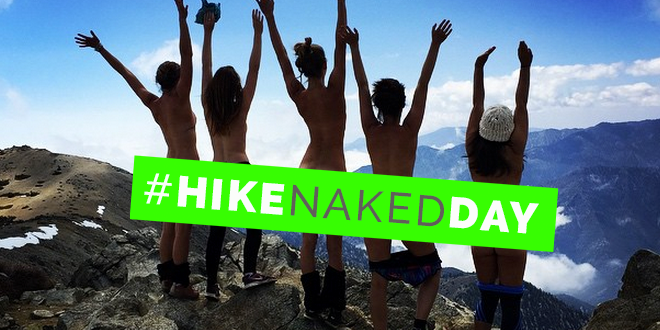
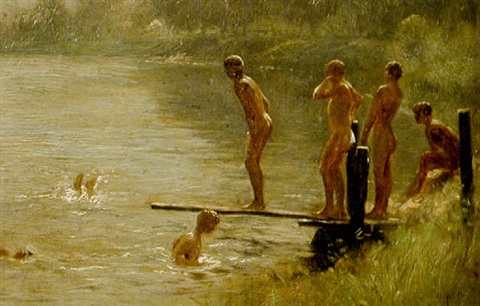
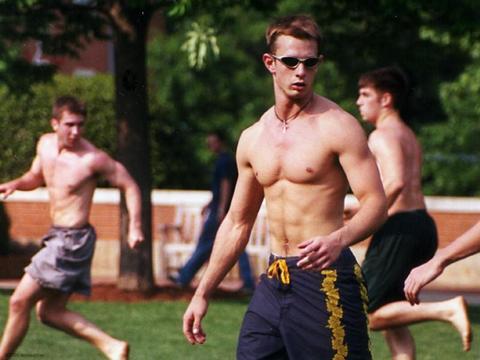

Another very fine post. It was sensible and factual.
“It would be distracting to the girls, the administrators argued.” Do you have any primary source material for this in the context of shirtless PE? I have come across a couple of news articles in the context of nude swimming so I don’t doubt your veracity. I just want to dig deeper.
As always, your essays are fantastic!
I’m sorry. I did come across that chauvinistic comment when I was searching various high schools for their PE dress rules, but can’t find it now. The consensus seems to be that gym suits (t-shirts and shorts) are issued to boys and girls and they are expected to wear them for gym class, whether indoors or outside. I’ve seen this at ETHS down the street from where I live and where my sons attended. Yet there are exceptions. Obviously swim class where boys wear brief trunks and girls wear one-piece suits. I don’t know how skins vs. shirts works in co-ed gym activities. 🙂
For swimming, swim shirts for boys seem to be increasingly common. For making teams, they didn’t do shirts vs skins when I went to school (mid 90s to late 00s). Instead, they gave us all “pennies” which are these colored vest-like things.
To answer the questioner directly, in my personal experience things started changing on the 1970s. I went to a men’s college and graduated in 1975. The school went coed shortly thereafter and naked swimming ended rather abruptly. I think our culture in general was changing at the same time, becoming more conservative in general and particularly around physical modesty.
I am also one of the men who swam naked the questioner was referring to. I swam naked at the Y from a very young age until well into adulthood. I first went to a public high school with no pool, then got a scholarship to a boys private school for my last two years and joined the swim team there. That enable me to get a swim scholarship to a men’s college. I always swam naked at the Y and HS, including meets. The Y I went to was smaller and meets were closed, open to members only. Most members were naked as well at these meets, including my father, as the facility was clothing optional in all areas in those days. I went to meets at larger facilities and some of the meets were open to the public as I recall. My family attend those meets at times. Because of the mixed audience, attendees were all clothed. I might add, coaches were naked at all these meets as well. At HS, all meets were by invitation only to family and friends at our school. Other school policies varied. We were of course naked at these meets but coaches wore suits then. So I was used to being naked around people and always thought it was perfectly normal. Lot to say here – I’ll continue in another post, if I may.
I definitely want to hear more about your experiences. There is so much debate about this fact of history. The group that wants us to think that it never happened seems to be winning. The small high school that I attended didn’t have a swimming pool, and I wasn’t really aware that some schools did. I was told by my shop teacher about the YMCA, since he had swam there. I have read accounts that talk of swimming meets where the boys were nude before mixed audiences. It is difficult for me to comprehend that, but there are people who claim that they swam at meets like that. I feel that it is very important to hear from people who swam nude in school, whether or not it was in front of a mixed audience, because these boys are now old men, or have already passed away. The fanatics are trying to remove any record that this ever happened. This is a very important part of history.
Glad you do – and yes – I truly believe it’s important to have a recorded history of the times when naked swimming and male communal nudity were considered normal and healthy for the development of boys and young men. Like Pastor Frank said, boys like to be naked – and I believe that’s still quite true today although sadly it is no longer deemed normal and acceptable most everywhere. In Spain, where I now live, it is fortunately and one reason I live here now. Nudity is allowed and acceptable on any beach in Spain but mostly beaches are considered either nudist or textile. That said, I walk almost daily along beaches – naked of course – and no one bats an eye when I pass a textile beach. On those normally textile beaches it’s quite common to see young boys naked – even teens, while the rest of the family are suited. Oftentimes, they’ll come up to me and tell me I look great and they intend to always remain naked at the beach. And I certainly hope they do. And I have many naturist friends with children who go to the beach together and they’re usually naked in their homes as well. I have one son who lives here now – he has four children – two boys and two girls. My son and grandsons are always naked at home – his wife and daughters are always clothed at home – but will go nude on the beach at times.
So I see daily where nudity is acceptable – boys and young men do not hesitate to join in.
My next post, I’ll get back to my own story.
This is one of the best perspectives on naked swimming I’ve read. I’d like to add how appropriateness is always in context to the greater culture. We typically define modesty in terms of covering up, but the definition of the word is: the quality or state of being unassuming or moderate in the estimation of one’s abilities. Although it’s before my time, I understand that the US post-war years were marked by strong conformism and had residues of the military culture. Therefore, some considered it immodest to wear clothes: what makes you think you should be any different or special in that suit than the naked rest of us? At the other extreme is the motivation for young men to towel dance in US locker rooms. I’ve been told that there may have no qualms with nudity among friends, but they have grown up where sex predators and gay cruising are thought to be commonplace. They don’t want to signal anything with nudity, whereas I always thought locker rooms were a designated space to be safe and naked.
Greetings Frank and others commenting.
I would like to open another line of thought on modesty.
I noted in the 90’s and early 2000’s that young men were wearing baggy clothes and layers of tee shirts and hoodies and baggy pants that hide the male form. Young women continued to wear cloths that displayed the female form. Why the difference?
I was talking to a mother who defended the right of her daughter and other young woman to wear clothes that displayed leg and “mid drift” as their right and men were not allowed to sexualise this. Yet in the same conversation she described men wearing speedos (brief swim wear) as Budgie smugglers. One standard for young woman and one for boys.
At preschool my grand children were told that the only people allowed to see their “private part” were their parents. Why call genitals Private parts?
I have two grandsons who listened to their mother going on about “Budgie smugglers” while they were pre-puberty. What message does this give them of their genitals that are about to enlarge?
In my father’s generation they talked about the “Family Jewels.” Now I see a post referring to “Junk.” What does this say about young men’s changing relationship with their genitals over generations?
I am not surprised to read that young women are more accepting of nudity in this generation. It seems that male nudity is being policed by society.
To return to the post I started in December, in college I was awarded a rather competitive swim scholarship. As I learned, I got the scholarship in part due lack of physical modesty. I was fortunate enough to grow up at a time that nudity for boys and young men was expected and ordinary. And I was naked at swim meets, summer camp, and our family lake cabin when others were clothed – I always thought I was the lucky one to be naked.
Part of the scholarship entailed assisting, and then managing, swim lessons for boys from town and surrounding area – as there was no Y there, and it was part of the college outreach to the community – many from disadvantaged backgrounds. As part of the interview process, I attended one of these lessons and helped out. The boys and instructors were always naked as per school policy and custom. Family was often in attendance. It was apparently evident I was always comfortable with nudity in those circumstances when other may not have been. And that apparently helped seal the deal for me – along with, oddly enough, that I had an intact foreskin. It seems boys who were intact were often teased for it – as circumcision was the usual custom in those days. Since I was intact, it was thought this would become a non-issue in the lessons – and it certainly was the case. I learned all these details sometime after I got the scholarship – but was glad I did. Part of the lesson in being comfortable with who I was and comfortable with my body that served me well in life.